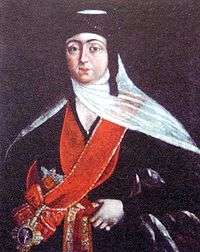Mariam Tsitsishvili
Mariam (Georgian: მარიამ ციციშვილი), also known as Maria in European sources, (9 April 1768 – 30 March 1850) was the Queen of Georgia as the second wife and consort of the last King George XII of Georgia (reigned from 1798 to 1800).
| Mariam Tsitsishvili | |
|---|---|
 | |
| Queen of Georgia | |
| Tenure | 11 January 1798 – 28 December 1800 |
| Born | 9 April 1768 |
| Died | 30 March 1850 (aged 81) |
| Burial | |
| Spouse | George XII of Georgia |
| Dynasty | Tsitsishvili (by birth) Bagrationi (by marriage) |
| Father | Prince Giorgi Tsitsishvili |
| Khelrtva | |
Family and early life
Princess Mariam Tsitsishvili was born at Tbilisi to Prince Giorgi Tsitsishvili and Princess Elena Guramishvili. By birth she was member of one of the preeminent noble houses of Georgia. George XII, then Heir Apparent to the Georgian throne, married her on 13 July 1783 after the death of his first wife, Princess Ketevan Andronikashvili (1754–1782). Mariam gave birth to eight sons and three daughters:
Later life
When George died on December 18, 1800, Paul I of Russia, an official protector of the Kingdom of Georgia, did not allow his heir, David, to be crowned king, and abolished the Georgian monarchy, annexing the kingdom to the Russian Empire.
In 1802, the newly established Russian administration started deporting the members of Georgian royal family to Russia proper. In April 1803, the Russian commander in Georgia, Prince Pavel Tsitsianov, himself a Russified Georgian and ironically a distant relative of the Georgian queen, heard that Mariam was planning to flee to the strongholds of Khevsureti with the aid of loyal mountainous clansmen who were resolutely opposed to the Russian rule.
Tsitsianov gave orders to Major-General Ivan Petrovich Lazarev that the queen and her children should be immediately removed from Georgia under guard. The very next morning, on April 22, 1803, the Russian soldiers arrived at Queen’s mansion and Lazarev ordered Mariam to get up and be ready for departure, but the queen refused to follow him. The general then took hold of her foot, to make her rise from the cushion on which she was sitting, surrounded by her sleeping children.[1] Mariam, indignant at the attempt to take her by force, drew the dagger from beneath the cushion and stabbed Lazarev, killing him on the spot. Lazarev’s interpreter drew his saber, and gave her a wound in the head, so that she fell down insensible. The soldiers burst into the bedroom and arrested the queen and her children. (?[2])
Escorted by a considerable armed force, they were carried away to Russia through the Darial Pass. During her passage through Georgia, the inhabitants came out to testify their loyalty to the queen and bade her farewell. She was kept into confinement at the Belogorodsky Convent at Voronezh until 1811 and then permitted to reside in Moscow. Little is known about Mariam’s life in Moscow, but she is known to have been regularly visited by Georgian students whom she helped financially. She died there at 82 and was interred at Svetitskhoveli Cathedral in Mtskheta, Georgia, with regal honors.[3]
The tragic story of Queen Mariam was described in several contemporary accounts, based on the reports of eye-witnesses, and found its place in European literature of that time.[4]
Notes
- Lang, page 46.
- Baddeley,Russian Conquest of the Caucasus, 1908(sic) has a different version. The queen feigned illness and when Lazarev arrived at the palace she was in bed. When she refused to budge he left, intending to arrange her removal by force. Just outside the door he heard a noise, returned and found her son and daughter fighting with a guard. He went to the queen to have her call off her children and she killed him with a dagger hidden in her bedclothes
- Lang, page 47.
- “Maria, the Last Queen of Georgia”. In: C. MacFarlane, editor (1847), The Book of table-talk, pp. 34-39. London: C. Cox; Henningsen, Charles Frederick (1846), Revelations of Russia in 1846, p. 350-1. London: H. Colburn.
References
| Wikimedia Commons has media related to Mariam Tsitsishvili. |
- Lang, David Marshall (1962), A Modern History of Georgia. London: Weidenfeld and Nicolson.
- (in Georgian) Papava, Tamar and Akaki (1956), მარიამ, უკანასკნელი დედოფალი საქართველოსი (Mariam, the Last Queen of Georgia). Buenos Aires.
- (in Russian) Tankov, A. (1901), Грузинская царица в Белгороде ("Georgian Queen in Belgorod"). Istoricheskiy vestnik № 3. Online version retrieved from the Vostochnaya Literatura project, 2008-07-11.
Mariam Tsitsishvili Born: 11 January 1798 Died: 28 December 1800 | ||
| Royal titles | ||
|---|---|---|
| Preceded by Darejan Dadiani |
Queen consort of Georgia 11 January 1798 – 28 December 1800 |
Monarchy abolished |